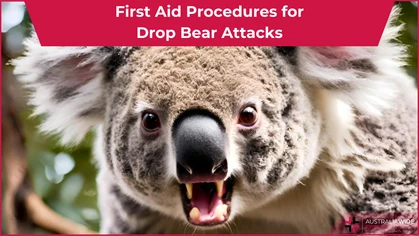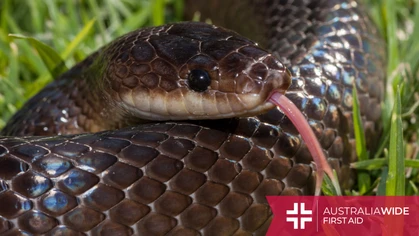First Aid for Marine Bites and Stings

Bites and Stings

A Sting in the Tale
First aid treatment for bites and stings from creatures in the sea is important, not just for pain relief, but because they could cause a severe allergic reaction – anaphylaxis. Identifying the culprit is the first step. The usual suspects are listed and described below.Bluebottles (aka Portuguese Man-of-War)
Bluebottle stings are the bane of many a beachgoer in Australia. Stings from this jellyfish type cause intense pain, rashes or skin redness. The pain fades, usually in an hour or two. When you come in contact with a jellyfish, stinging cells (nematocytes) on the tentacles, like tiny harpoons, inject their poison. The sting's severity will depend on how much contact was made with the tentacle and the species of jellyfish. First aid for bluebottle stings involves carefully removing any remaining tentacles from the skin, wearing gloves if possible, or washing them off with seawater. Treat the sting by running hot water over or immersing the sting site for at least 20 minutes. Water temperature should be around 45°c and not too hot for the person to tolerate. If hot water is not available, apply an ice pack or cold water to the affected area. Do not use this method for box jellyfish or Irukandji stings. Do not use vinegar. Do not rub sand, pour soft-drink over, or urinate on any jellyfish sting. If further symptoms develop, such as abdominal pain, nausea, vomiting, or when pain, itchiness or blistering continues at the site, seek medical attention.Box jellyfish, Irukandji, tropical stingers
Tropical stingers (jellyfish) – box jellyfish and Irukandji being the most dangerous – can be found in the waters around Australia’s coastline, from Bundaberg in Queensland to Geraldton in Western Australia. Stinger season usually peaks from November to March. Box jellyfish stings cause severe pain. Other symptoms can include red or purplish whip-like lesions on the skin, increased heart rate, severe pain elsewhere in the body, sweating, anxiety, nausea, vomiting, and cardiac arrest. Irukandji sting symptoms include severe backache or headache and shooting pain in the muscles, chest and abdomen. Nausea, vomiting, anxiety, restlessness, and breathing difficulties can also be experienced. First aid recommendation is to call triple zero (000) for an ambulance. Deactivate the sting by pouring vinegar liberally over the tentacles for at least 30 seconds. Remove any remaining tentacles. Vinegar stops nematocytes that haven't already fired venom from firing. If vinegar is not available, wash the affected area with seawater. Do not use fresh water. Do not substitute vinegar with alcohol or methylated spirits. These solutions would make the sting worse. Commence cardiopulmonary resuscitation (CPR) if the person loses consciousness. Keep the person calm, while you are waiting for an ambulance. If you&pos;re unable to clearly identify the stinger in tropical waters, seek medical assistance and treat the sting with vinegar.Stonefish
Stonefish look like rocks, lying in the mud or sand, and blending in with their habitats all around the Australian coastline. Spines along the stonefish’s back, release a toxin that makes them very dangerous. A stonefish sting causes severe pain and swelling. The person may go into shock. They will probably need hospital treatment to receive stonefish antivenom and for further pain relief. Call triple zero (000) for an ambulance. To relieve pain in the meantime, soak the affected area in hot water (no hotter than is easily tolerated) for 20 minutes. A hot shower is an alternative. Continue with hot water immersion if pain continues. It's better, of course, to avoid stonefish stings. Some protection is provided by wearing thick-soled shoes and shuffling your feet when walking in the shallows. Avoid picking up rocks from the reefs – they could be stonefish.Blue-ringed octopus, sea snake, coneshell
A bite from a blue-ringed octopus or a sea snake is very dangerous. So too a sting from a coneshell. Along with pins and needles, nausea, and dizziness, the victim may not suffer too much pain but end up feeling very unwell. Call triple zero (000) for an ambulance if the person loses consciousness. Provide emergency care including cardiopulmonary resuscitation (CPR) if needed. Apply a pressure immobilisation bandage and keep the person calm and still while awaiting the ambulance. See our guide to the pressure immobilisation technique.Fish stings
Venomous or spiny fish, such as red rock cod in New South Wales, and soldier fish and cobblers in southern Australia, can cause injuries when they are handled. Pain from these fish is immediate, severe and lasts up to an hour, but with minimal other effects. First aid to treat fish sting injuries:- Remove any pieces of spine
- Immerse affected area in hot water or shower (up to 45°C) until the pain goes away, or for a maximum of 90 minutes. Test the temperature first on an unaffected limb
- Painkillers can be used to treat the pain
Sea urchins
Sea urchin injuries are mostly non-venomous and removing the spines is the main problem. Venomous spines cause more intense pain but are less common. First aid to treat sea urchin injuries:- Remove spines close to the surface
- Immerse affected area in hot water or shower (up to 45°C) until the pain goes away, or for a maximum of 90 minutes. Test the temperature first on an unaffected limb
- Painkillers can be used to treat the pain
Sponge injuries
Sponge contact reactions are not common and after a time, they become more difficult to diagnose. Initially, only a mild sensation might be noticed. Itchiness and stinging can develop later, in some cases, becoming intense after 2 or 3 days. First aid comprises only washing the sting site and analgesia to manage the pain. Symptoms usually fade away over time.How to prevent marine bites & stings
- Swim between the flags at patrolled beaches and inside stinger nets if available
- Do not enter the water when the beaches are closed
- Wear a full-body lycra suit for protection from tropical stingers during stinger season
- Do not touch stingers on the beach – they can still sting
- Scan the scene and enter the water slowly, giving marine creatures time to move away
- Ask the lifeguard if stingers are present before entering the water
Do I need first aid training?
A first aid course costs very little in light of its potential to save a life. It also gives you the confidence of knowing how to handle a medical emergency. You can become first aid-qualified in just one day. Browse our courses.
Originally published at
https://www.australiawidefirstaid.com.au/resources/first-aid-for-marine-bites-and-stings
as part of the Australia Wide First Aid Articles Library









